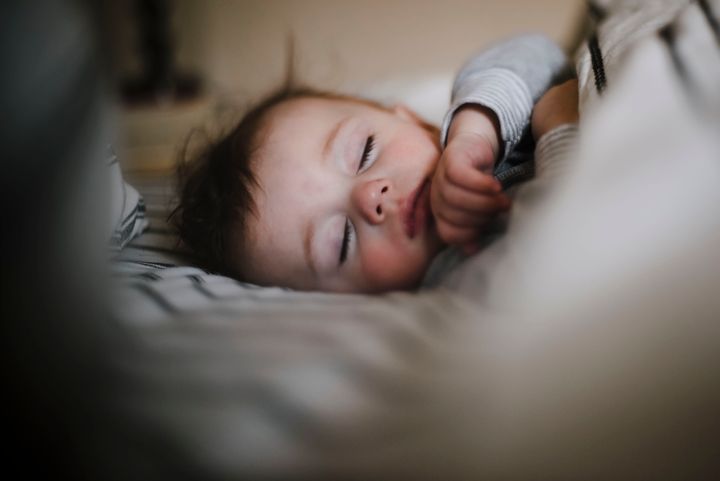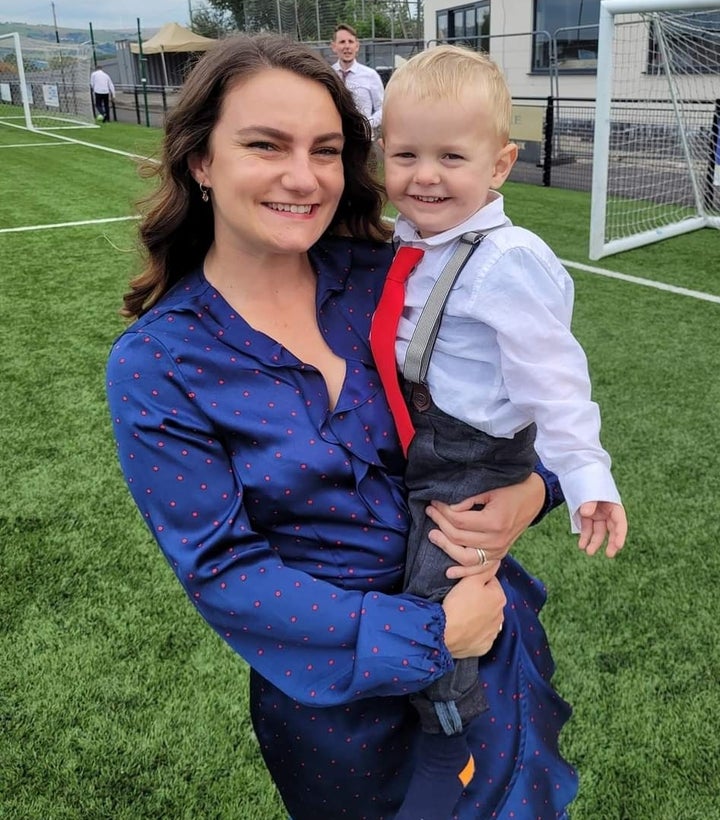
When it comes to raising kids, bed-sharing – sometimes called co-sleeping – is perhaps one of the most divisive topics.
Those parents who have gone down this route will have undoubtedly seen the search results telling them they’re going to kill their baby. They’ll have heard the phrase ‘you’re making a rod for your own back’ at least 300 times, too.
But despite this, bed-sharing is super common, says child sleep expert Lauren Peacock, from Little Sleep Stars.
“Studies show that in the UK, by the time a baby is three months old, half will have bed-shared with a parent at some point,” she tells HuffPost UK.
The sleep expert adds that of the families she speaks to in her practice, around 20% bed-share all or most of the time. A further 40-50% do so some of the time.
For the uninitiated, bed-sharing is exactly that: sharing a bed with your kid. Co-sleeping can also mean bed-sharing, but sometimes it simply means sleeping near to your child – so they might be in the same room as you in a crib, not necessarily in the same bed.
Bed-sharing is a taboo topic for a couple of reasons. The main one, suggests Peacock, is because of the public health messaging around bed-sharing and sudden infant death syndrome (or SIDS).
“For several years now, parents in countries such as the UK and the US have been warned against this, being advised that doing so increases the risk of sudden infant death syndrome (SIDS),” says the sleep expert.
Perhaps one of the more extreme examples of this type of warning came from a Milwaukee public health advert in 2011, which showed a photo of a baby sleeping next to a huge meat cleaver, with the caption: “Your baby sleeping with you can be just as dangerous.”
Understandably, it didn’t go down well among lots of parents who were bed-sharing safely with their children.
“For several years now, parents in countries such as the UK and the US have been warned against this, being advised that doing so increases the risk of sudden infant death syndrome (SIDS).”
- Lauren Peacock, sleep expert
The warning of infant death is “a very powerful message”, says Peacock, “and one that has persisted despite the overall discussion around bed-sharing and SIDS becoming much more nuanced in recent times”.
It is estimated that around half of SIDS deaths occur whilst co-sleeping, according to the Lullaby Trust. But most of these are in ‘high risk co-sleeping situations’ – for example, if a parent smokes or has drunk alcohol, they fall asleep with baby on the sofa, or there are loose covers which could end up over their baby’s head.
Bed-sharing can be done safely, as thousands (if not millions) of parents will attest. (In fact the Lullaby Trust has some great guidance for those looking to practice safer bed-sharing.) But we wouldn’t know about it, because sadly lots of parents are too ashamed to admit it. They are silenced by stigma.
Grace Redmond, 27, from Rossendale, bed-shared with her little boy until he was two years old because she found it easier to continue breastfeeding this way and she also found she got more sleep.
“There was a lot of pressure to stop this,” the operating department practitioner working in the NHS tells HuffPost UK, describing how it was viewed by others as “unhealthy” and “not teaching independence”. A lot of the pressure came from the internet, she adds, saying she’d come across comments on articles criticising bed-sharing parents.

Unfortunately when it came to telling people about their bed-sharing, she found she would twist the truth or simply not say anything at all because people held such strong opinions on it.
She recalls how at her son’s one year check, she told the health visitor her son was still sleeping in their room, just not in their bed.
“When I returned to work the big question people wanted to know was about how well my little boy slept and the eye rolls came when I said about bed-sharing, so eventually I stopped telling people about it,” she explains.
Her story is sadly not unique. After interviewing 51 parents who co-slept with their children for her book on the subject, Susan Stewart, a professor of sociology at Iowa State University, found half of the parents denied or avoided discussing it with family or their paediatrician because of stigma.
Another survey of 600 parents, this time by parenting expert and author Sarah Ockwell-Smith, found that 46% hadn’t admitted to sharing a bed with their newborns to a GP, midwife or health visitor for fear of being judged.
Even the National Institute for Health and Care Excellence (NICE), which informs healthcare guidance in the UK, acknowledges that while sharing a bed with babies is common practice among parents, “there is often confusion and mixed messages about it”.
It suggests giving parents advice at each routine postnatal contact about safer practices for bed-sharing. It also advises about instances where bed-sharing is strongly advised against, for example in high-risk situations.
Another reason why bed-sharing is such a taboo is that parents are often worried that it will hinder their child’s independence or their ability to sleep through the night, adds Peacock.
“It won’t,” she clarifies, “but it’s a strong narrative that heaps pressure on parents not to bed-share.”
Studies have found a plethora of reasons why families choose to bed-share: from cultural norms, to coping with a baby or toddler’s sleep problems, to feeling safe in the thought you can watch over and protect your child (from a fire or burglars, for instance) if they’re beside you.
For Redmond, the main benefits were the extra sleep and ability to feed him in the night, which she says helped their breastfeeding journey. The mum also says she loved having him nearby. “His illnesses never seemed to last long and I’m sure bed-sharing helped with this,” she adds.
Bed-sharing – while a beautiful bonding experience and a great way to get back to sleep quickly if your little one wakes up at 3am – can, like all things, have its pitfalls. One Norwegian study found bed-sharing was associated with more nighttime awakenings and shorter sleep duration in little ones.
It can also mean evenings become limited if you are going to bed at the same time as your child, as Redmond explains: “We had a year or so of not staying up later and having time together as a couple watching our programmes or having any downtime.”
It’s perhaps unsurprising then that bed-sharing is one of the most common things parents are seeking support to change when they speak to Peacock.
“Some families who choose to bed-share wait until the child requests their own bed to move them out,” she says. “All children will make this choice eventually.”
But for others, sharing a bed with an increasingly active toddler or young child just might not work anymore – perhaps not everyone is sleeping well, there is a new baby on the way or it just feels like time for a change.
Sadly, there isn’t some magic age that guarantees the move will be plain-sailing, so she recommends the best time to make the transition is “when the change to who sleeps where feels worth going through the process to get there”.
If you’re ready to embark on a journey to sleep independence, the first rule is to give your child a heads up that the change is coming, at least a few days before the move, suggests the sleep expert.
It’s useful to have a familiar and positive pre-sleep routine in place before you transition a child to their own bed, so that there is consistency in the run up to sleep.
“Then go for it,” she says. “Lots of children adapt brilliantly to a new sleep-space whereas others need a little more support before they are comfortable with the idea – but they all get there in the end.”
In the short-term, your child may take longer to settle at bedtime, wake more frequently and you might spend chunks of time in their new room providing support, so it’s worth making the transition at a time when you can afford for things to be disrupted for a while. (So basically not during a busy week at work!)
If you are helping guide them back into their own bed, don’t make too big a deal of the upcoming move or overhype how “exciting” it’s going to be, warns Peacock.
“Be sure that you are ready for your child to move – if parents are anxious about the change, little ones will pick up on that and start to have doubts themselves.
“Once you have made the decision to move your child to their own room, stick with it, expecting that some children will need more parental help than others to adjust to solo sleep.
“Chopping and changing where your child sleeps creates confusion, and usually crying, so if you decide your child is moving, commit to that.”
As for Grace Redmond, her son, now 28 months old, is sleeping soundly in his own bed at night. “He is so confident and happy,” she says.
And contrary to popular belief, there were very few issues getting him there. The family started talking about his bed in his own room before bedtime and started some daytime naps in there to make it a positive safe space.
“We went straight for a toddler bed instead of cot so he had freedom to climb in and out himself,” says Redmond.
“We still responded to his needs as soon as he woke up, day and night. Once we felt he was ready, we started the bedtime routine in his bed such as stories and a cuddle so then eventually he started falling asleep in there.
“Now straight after brushing his teeth he walks to his room without hesitation.”
She concludes: “It was such an easy transition compared to the way it had been made out by society.”
Lauren Peacock is resident sleep expert at Koko Sleep, listen to a sleep story wherever you get your podcasts and on Apple.